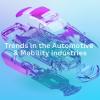Industry
The status quo is changing for most industries as boundaries blur between fields due to innovation, disruption, and digitally-driven change. That’s why keeping abreast of emerging trends in sectors outside your own is vital, not only because your organization’s competitive landscape may be changing, but because there are universal, strategic lessons to learn from the opportunities and threats convergence poses for every marketplace. We examine emerging trends and the impact of evolving tech in key fields such as healthcare, financial services, telco, energy, mobility, and more to help you capitalize on the possibilities of the future while managing the challenges of today.
Insight
Antonios Kaniadakis sets out to illustrate that banking disruption is not being driven by technologies like AI and decentralized platforms. Rather, he believes it stems from technology commoditization and industry players repositioning themselves within the sector — becoming disruptors, innovators, fashion-setters, or all three.
Daniel Gozman and Jonas Hedman describe a modular architecture approach to taking banking to the next level. Modular architecture lets banks build their value propositions into services, functionalities, and raw data while enabling new distribution and service creation. Using a four-pronged framework, the authors explain how banks can continue their current role as integrator while expanding into roles such as producer, distributor, and platform.
Arthur D. Little’s Ignacio Garcia Alves, Philippe De Backer, and Juan Gonzalez tell bankers in no uncertain terms that they cannot stall the shift to digital transformation. Legacy systems have been a major factor in this delay, but banks have a chance to come out ahead of fintechs — provided they have the right answers to 11 key questions.
With AI systems now equaling or exceeding human performance, it’s increasingly important to understand the reasons a prediction is made. This is especially true in banking, where financial stability is at risk if the underlying mechanisms driving market-moving decisions are not well understood and where consumers must be protected from technology-related bias. Cigdem Gurgur explains the limitations and possibilities inherent in XAI and gives examples of AI’s potential to increase accuracy and fairness over the current statistical models guiding credit and lending decisions.
To survive and thrive, traditional banks must adopt a more exploration-oriented mindset. Leaders must act quickly to implement radical changes on all fronts, balancing short-term value drivers with innovation to spur growth and transformation. Those who can harness change to their advantage will shape the future of finance.
It is becoming very clear that, with growing populations and urbanization around the world, both the automotive and mobility sectors must find new ways to prevent the collapse of traffic and transport ecosystems. Manufacturers and service providers should enter into new, cross-industry partnerships and be open to changes in business models
Olivier Pilot, Francois-Joseph Van Audenhove, and Mickael Tauvel have been studying the reasons traditional approaches to MaaS have failed, and they offer a model for a mature, value-creating MaaS initiative. It starts with digitally enabling organizational authorities to manage multi-modal mobility and connect users’ digital experience with physical access. As the authors suggest, account-based ticketing is key to this transition, decoupling a MaaS user account from the mobility-access device; simplifying account management; and allowing sophisticated, multi-modal back-end fare rules. They also argue for moving beyond the traditional plan-book/ticket-pay approach in favor of know-and-go.
Cutter Fellow Robert Charette takes an in-depth look at the electric vehicle (EV) market in the next decade. Currently, automakers are focused on dethroning Tesla, which disrupted the auto ecosystem with its skateboard battery and advanced autonomous driving capabilities. Where charging will take place and how the world can produce enough EV batteries are major considerations in this initial skirmish. But the real battle begins around 2025, when EV makers shift their focus to production efficiencies and lifecycle sustainability as they battle against ICE vehicles for market share. Around 2030, the winners will emerge into a world of new technological competitive threats.





















